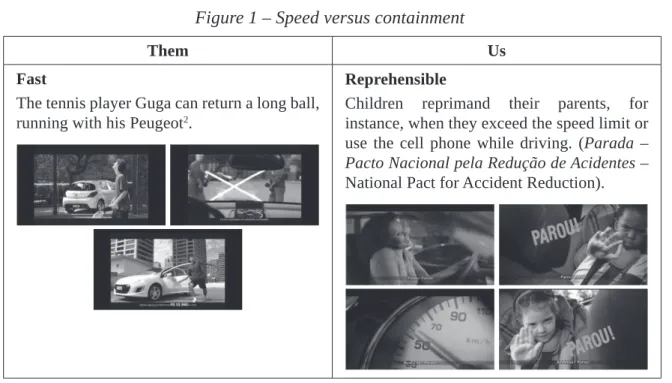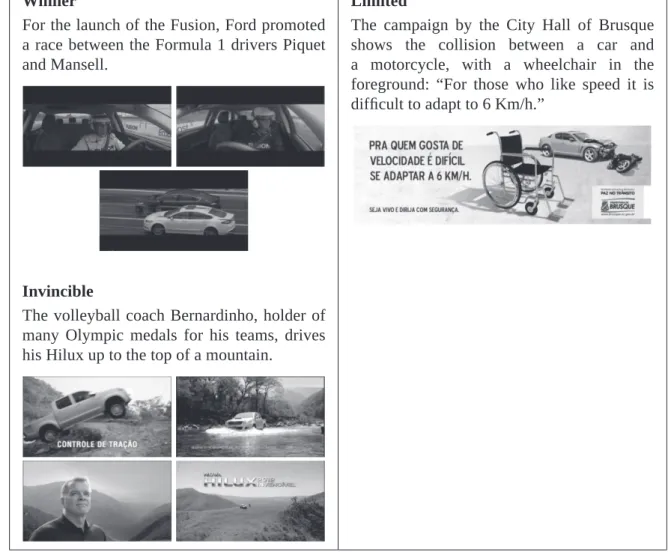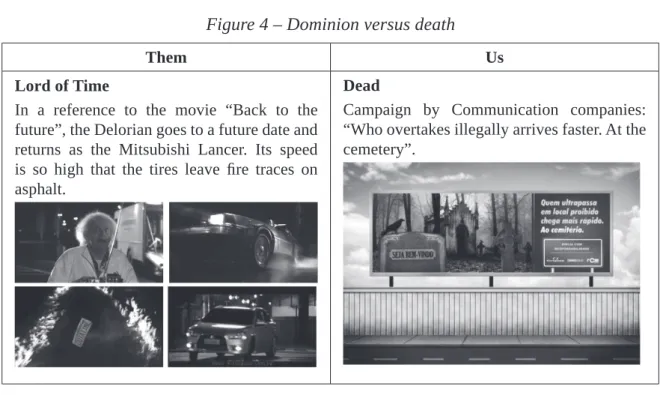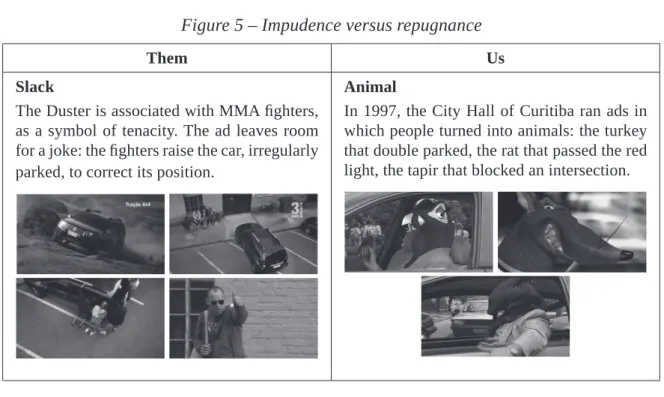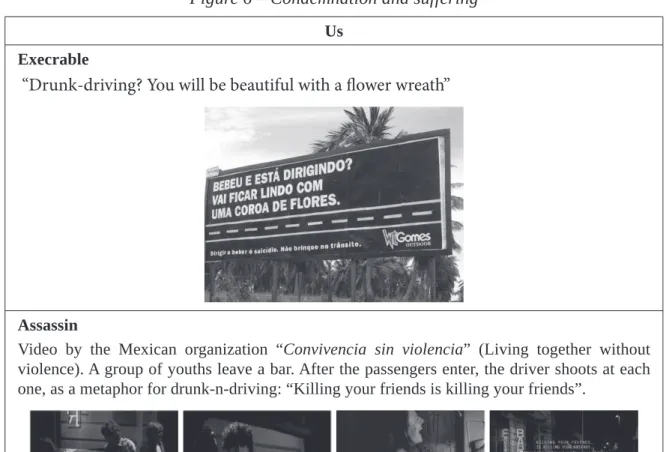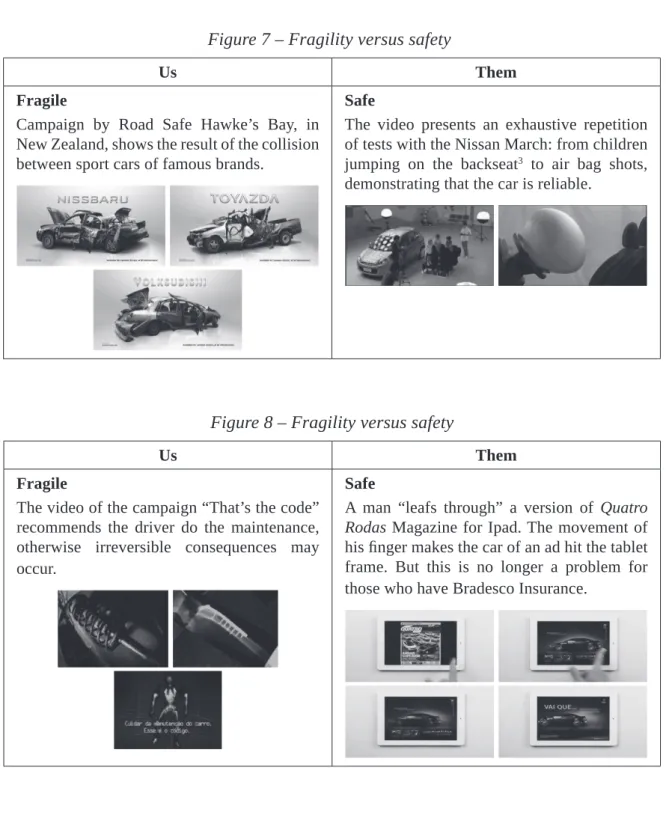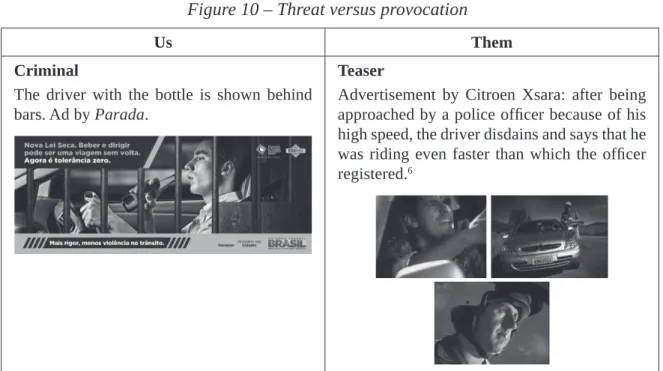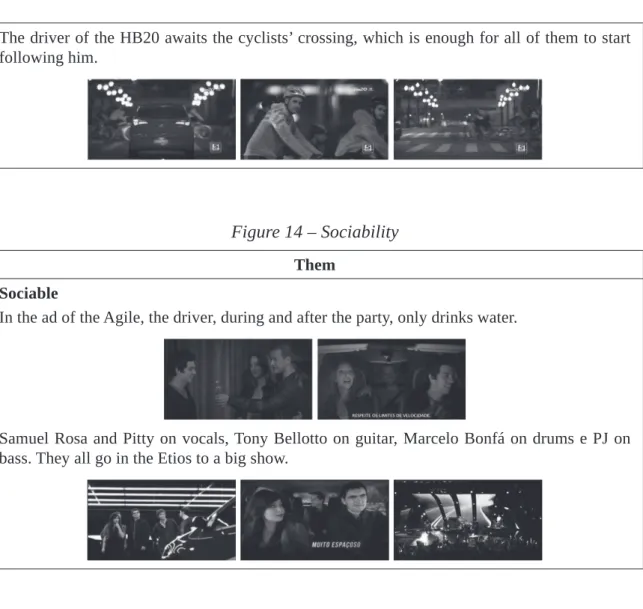DOI: 10.1590/1809-5844201617
Ana Marusia Pinheiro Lima Meneguin
(Universidade de Brasília, Instituto de Ciência Política, Doutorado em Ciência Política. Câmara dos Deputados, Centro de Formação, Treinamento e Aperfeiçoamento, Programa de Pós-Graduação. Brasília – DF, Brasil)
Abstract
This paper aims to identify the recurrent elements in the discourse of Advertising in the composition
of the imagery on road trafic, highlighting the car driver as the preferential addressee, in both
commercial and social campaigns. With the theoretical and methodological support of the French Discourse Analysis, it compares several advertisements aired from 1990. The meaning-effects
are evidenced to the extent that it turn into questionable the choice of the approach and the very Advertising as instrument for change in behavior, in a country where the car, more than an object of desire of individuals, is an object of desire of the State. At the end, some perspectives on road trafic
safety are presented.
Keywords: Advertising. Social Issue Advertising. Road Trafic. Discourse Analysis. Imaginary.
Introduction
Advertising has been one of the tools used in joint efforts to combat road trafic violence. It is questioned, however, if it has succeeded in that attempt, especially when it
confronts other contradictory Advertising appeals.
Advertisers and Advertising agents employ several techniques in campaigns for
trafic safety. The model comes from commercial advertising or from the ancient propaganda of ideas. Nonetheless, even among the public service announcements, the advertisements about trafic issues are rather different: instead of having an appeal as a support, they mostly
present a “counter-appeal”.
There is nothing to buy, nothing to adopt, nothing to do; there is what not to do: not
to speed, not to drink and drive, not to use cell phones, not to pass red lights, not to cross
a solid yellow line. These behaviors are present in the statistics of the leading causes of
tragedies, evidencing the human factor – in particular the conduct of the car driver – as
preponderant in the trafic issues. In sum, the recommendation is “not to live dangerously”. The most widely used strategy of the campaigns shows what can happen if the person
insists on living dangerously.
Pinsky and Pavarino Filho (2007) point out that the severity of collisions and
consequential damages are multiplied with the increasing of speed, although there may be other variables involved. Speed control itself is already a powerful ally for the trafic safety.
There is something that supports the insistence on risky behavior; in this case, high speed. This is a time when the more rapid, the better. More than a reason, it is an emotion. It belongs to the symbolic realm and has been associated with the automobile since its beginnings: it conjures the feeling of freedom, control and power (FRASCARA, 2009, p.25). It endows with greatness the most insecure of egos, which explains why Advertising inds a breeding ground in young minds (MARIN; QUEIROZ, 2000, p.14).
It is necessary to discover if ighting against it is or is not productive, or even prejudicial. This is the question that Michel Pêcheux (1979, p.82), the founder of the Discourse Analysis, asks about Advertising1: if it works so well for them, why wouldn’t it
work for us?
In the irst section, this paper seeks to identify what is “good for them” (car culture) and what has been used “by us” (trafic safety). The corpus consists of several advertisements presented since 1990, focused on the car driver. Then, the meaning-effects that emerge from this dispute are analyzed. In the third section, it evaluates Advertising as an instrument for
change in attitudes and, inally, it presents two perspectives on trafic safety: the concrete and the symbolic. The French Discourse Analysis gives the theoretical and methodological bases for the study.
Commercial Advertising of cars and Social Issue Advertising for trafic safety:
them and us
The power of Advertising (including commercial Advertising and social issue
Advertising) comes from the contract it establishes with its target audience (MENEGUIN,
2009, p.104). The main clause is the expectation of achievement. That is, the addressee
follows the advertisement by believing in the promise that she/he will be able to reproduce in her/his life what happened in the Advertising scenery. This “realization” transcends the “real”, reaching the symbolic dimension. It goes far beyond the concrete beneit that a given product offers, to be assumed as the way the subject “feels” when she/he acquires or uses it.
The real and the symbolic are inseparable. Without the perception of the concrete aspect, the symbolic is changed, and the opposite effect may occur, as in the case of an unrealized promise. At the same time, the symbolic also creates realities.
What are the promises of the commercial Advertising of cars? How are they related to “the way of living dangerously”? The regularity in the advertisements can be summarized in the promotion of the conquest (MENEGUIN, 2009, p.49-60):
• of the self (as someone respectable, admirable, skillful and fearless);
• of the object (car);
• of time (speed)
• of space (GPS, good roads, empty cities, lone car);
• of the group;
• of sex;
• of the consumer good (car insurance).
As Pêcheux states (1969, p.77), “the discursive process has no actual beginning”. A discourse always refers to another one, as a “direct or indirect answer to it, and it ‘orchestrates’ its major terms or overturn its arguments”. The social issue campaigns for trafic safety are answers to cars sales ads. And vice-versa, indeinitely.
Below, the left columns of the Figures 1 to 4 contain the adjectives that concern the
car drivers and are recurrent in commercial advertisements – “Them”. The right columns
bring the counterpoint of those adjectives, as presented by the social issue Advertising for road trafic safety – “Us”.
The selection of the corpus was guided by the representativeness of the advertisements in each discursive formation. In most cases, the exempliied ads did not have the same scheduling neither the places of media divulgation. The analysis is not directed by their interpretation as isolated elements, but by the way they produce meaning-effects as symbolic objects in order to have access to the discursive process of which they are a part, according
Figure 1 – Speed versus containment
Them Us
Fast
The tennis player Guga can return a long ball, running with his Peugeot2.
Reprehensible
Children reprimand their parents, for
instance, when they exceed the speed limit or use the cell phone while driving. (Parada –
Pacto Nacional pela Redução de Acidentes –
National Pact for Accident Reduction).
Figure 2 – Highlight versus execration
Them Us
Center of attention
Speed is not exclusive to videos. It is also
evoked in the print ads, such as in this one
of the Cruze: “Have you ever seen someone stand out by being like everyone else?”
Execrable
Road panels produced by the very Advertising
companies (Grupo de Empresas Exibidoras
de Mídia Exterior – Group of Exhibitor
Companies of Exterior Media) satirize the behavior of reckless drivers: “Is your father speeding on the road? Scold him”.
2 The route reproduces the streets of a city, even if the video shows the subtitles “scenes in a controlled environment”. Conselho
Nacio-nal de Autorregulamentação Publicitária - Conar (Brazilian Code of Advertising Self–Regulation) received a denunciation of “example
Figure 3 – Victory versus limitation
Them Us
Winner
For the launch of the Fusion, Ford promoted
a race between the Formula 1 drivers Piquet and Mansell.
Invincible
The volleyball coach Bernardinho, holder of
many Olympic medals for his teams, drives
his Hilux up to the top of a mountain.
Limited
Figure 4 – Dominion versus death
Them Us
Lord of Time
In a reference to the movie “Back to the future”, the Delorian goes to a future date and
returns as the Mitsubishi Lancer. Its speed is so high that the tires leave i re traces on
asphalt.
Dead
Campaign by Communication companies:
“Who overtakes illegally arrives faster. At the cemetery”.
The illegal overtaking was classii ed as speeding. After all, there is no need to pass
another vehicle if there is no haste.
Figure 5 – Impudence versus repugnance
Them Us
Slack
The Duster is associated with MMA i ghters, as a symbol of tenacity. The ad leaves room for a joke: the i ghters raise the car, irregularly
parked, to correct its position.
Animal
In 1997, the City Hall of Curitiba ran ads in which people turned into animals: the turkey that double parked, the rat that passed the red light, the tapir that blocked an intersection.
Some condemnable behaviors pointed out by the trafi c safety campaigns (Figure 6) do not i nd specii c counterparts in the car Advertising. For instance, incentives to the non-use of seatbelt or to the alcohol/driving combination were not found in any of the
commercial Advertising pieces that compose the corpus3
.
3 The alcohol/driving combination, however, is present in the succession of ads of the same commercial break or on magazine pages.
In his book “Cultura de Segurança no Trânsito” (Culture of Safety in Trafi c), J. Corrêa quotes Cilene Potrich, Master in Education: For
Figure 6 – Condemnation and suffering
Us Execrable
“Drunk-driving? You will be beautiful with a fl ower wreath”
Assassin
Video by the Mexican organization “Convivencia sin violencia” (Living together without
violence). A group of youths leave a bar. After the passengers enter, the driver shoots at each one, as a metaphor for drunk-n-driving: “Killing your friends is killing your friends”.
Relative or friend of a victim
The son of the singer Leonardo fell asleep while driving and overturned his car. The singer gives a testimony in the video by Parada.
The replies
The commercial ads (on the right) counter the criticism (on the left), trying to
neutralize them with rational arguments or even by disqualifying them, with disdain and
Figure 7 – Fragility versus safety
Us Them
Fragile
Campaign by Road Safe Hawke’s Bay, in New Zealand, shows the result of the collision between sport cars of famous brands.
Safe
The video presents an exhaustive repetition
of tests with the Nissan March: from children jumping on the backseat3 to air bag shots,
demonstrating that the car is reliable.
Figure 8 – Fragility versus safety
Us Them
Fragile
The video of the campaign “That’s the code”
recommends the driver do the maintenance,
otherwise irreversible consequences may
occur.
Safe
A man “leafs through” a version of Quatro
Rodas Magazine for Ipad. The movement of
his i nger makes the car of an ad hit the tablet frame. But this is no longer a problem for those who have Bradesco Insurance.
Figure 9 – Fragility versus safety
Us Them
Fragile
“Learning to walk. This is natural only on the i rst time. Don’t let a trafi c accident make
you relearn.” Campaign of the National Week
for Trafi c in 2013.
Safe
The more striking example is the video of
the Ka Sport5. Ele traz todos os elementos
tradicionais de um “racha”. Ao i nal, o Ka
freia diante de um precipício, mas o Dragster
não. A morte é banalizada, como em um
videogame ou desenho animado.
Figure 10 – Threat versus provocation
Us Them
Criminal
The driver with the bottle is shown behind bars. Ad by Parada.
Teaser
Advertisement by Citroen Xsara: after being approached by a police ofi cer because of his
high speed, the driver disdains and says that he
was riding even faster than which the ofi cer
registered.6
In other moments, speed is shown as a needed and desirable quality for the well-being of society, in contrast to social issue Advertising, which attributes only negative
aspects to haste (Figure 11).
Figure 11 – Damage versus necessity
Us Them
Harmful
“Haste always takes suffering in the ride.”
Necessary
A man, driving a Fiesta, chases two criminals. Suddenly, he overtakes them, causing the rollover of their vehicle. The police ofi cer comes and arrests the two transgressors.
6 Conar forbade the exhibition of this ad on TV. Despite that, it is available on YouTube and open for user comments. The permanency of videos on the internet is essential to comprehend the current reality, because it goes far beyond the traditional period of advertising
Positive reinforcement
The relationship between “Us” and “Them” is not always a clash. Figures 12 to 14 show several ads by automakers. All drivers act in a way that deserves the adjectives given by Advertising: they wear seatbelts (even in the back seat), drive at a speed that suits the conditions, stop before crosswalks, respect cyclists. One of them even refers to the
“designated driver”7
.
Figure 12 – Respectability
Them Respectable
The video by the Fiat Linea enumerates everything that make a man “more respectable”: tie, meeting, business card, a clean-shaven face... and the Fiat Linea.
Figure 13 – Admiration
Them Admirable
In the video by the Corolla, a red carpet rolls out for the car. By stopping at the red light, the driver receives the crowning admiration: the look of the pedestrian.
The driver of the HB20 awaits the cyclists’ crossing, which is enough for all of them to start following him.
Figure 14 – Sociability
Them Sociable
In the ad of the Agile, the driver, during and after the party, only drinks water.
Samuel Rosa and Pitty on vocals, Tony Bellotto on guitar, Marcelo Bonfá on drums e PJ on bass. They all go in the Etios to a big show.
The ads with the adjective “Sociable” are examples of “carpooling”, motivating the solidarity between friends.
The advertisements in the left column in Figure 15 do not sell cars. Supported only by the brands, they sing along to the tune of the campaigns for trafi c safety, in the right
Figure 15 – Kindness, attention and awareness
Them Us
Ads by Fiat.
Kind
“There are enough angry faces on the road. Drive friendly”.
Aware
“You either see the letter or the girl. Don’t text while driving”.
Conscious
In the video by the Government of Pernambuco, a highway patrol ofi cer is inside the car praising everybody who is wearing seatbelts.
“Cool driver is conscious driver. Respect the speed limits, the trafi c signaling and only
overtake to the left”.
Discourse analysis: Meaning-effects
Brands are entities that have virtual existence. They occupy a space in the consumers’ lives, give meaning to their choices and are treated, by them, like people in their lives. They create
identities for their users. And approximate the consumer to his/her ideal self.
For Keller (1993 apud TROIANO, 2003), the brand equity can explain the difference in sales among identical products of distinct brands.
The brand concept, allied to the expectation of realization, modiies the meaning of an advertisement. An ad for trafic safety changes when the government’s signature, for instance, is replaced by the brand of a shock absorber company. The brand comes as a quick solution, unlike the message from the government, which preaches permanent conduct.
Social issue Advertising cannot supplant the connection between consumer and brand. First, due to the differences of imageries (Chart 1): with whom the addressee tends to identify?
Chart 1 – Comparison of adjectives – Them and Us
Them Us
In marketing, the brand gives, to the addressee, access to a fantastic world: YOU CAN BE LIKE THIS:
• Fast
• Center of attention • Winner
• Invincible • Lord of time • Slack • Secure • Teaser • Necessary • Respectable • Admirable
• Sociable
Most of the time, social issue campaigns for trafic safety generalize and label the viewer – you ARE like this; see what will happen to
you:
• Reprehensible • Execrable • Limited • Dead • Animal • Assassin
• Relative or friend of a victim • Fragile
• Criminal • Harmful
Second, social issue ads focus on the consequences, not the causes. They do not focus on what precedes the behavior adopted by the individual.
Another aspect that neutralizes the discourse of the social issue Advertising for
trafi c safety is the unrealized promise: this is the case of the driver who violates the laws, act in a risky way and, in the end, there is no punishment, no collision, no death.
When the images are compared (Figure 16), the “unsafety” is entirely and paradoxically on the right (“Us”):
Figure 16 – With whom does the audience identify?
Going further in the paradox, those images can raise contrary attitudes and encourage risk.
It is important to underline that promises of living dangerously are not exclusive to
car advertisers. The Advertising and the entertainment industries, as a whole, reinforce the
stereotype of the risk, mainly directed to young people.
While the marketing of vehicles works with the triad of freedom / control / power, Advertising for trafi c safety insists on another triad: fear / guilt / desire for revenge.
Figure 17 – The deserved death
Us
Once a man gets rid out the wreckage of an overturned car on the road, he is struck by another
vehicle.
Unless there is identii cation from the audience, this kind of discourse generates projection: the guilty is always the other. The other is a reprehensible, execrable, an assassin, animal, and deserves to die, as in the French ad. The negative campaign, without backing, ends up creating a “bellicose” predisposition in each person that enters the transit.
In all meaning-effects analyzed, the most remarkable is the maintenance of an imagery of violence in trafi c, under the argument of convincing people by shock. Nevertheless, a real offender is not the target audience. One who commits a trafi c crime and is not impressed by it, will hardly be impressed by Advertising.
It is worth mentioning, also, the disparity of the discourses in Advertising. The Government is one of the leading advertisers of trafi c safety campaigns. When it submits the concept, “be the change in trafi c”, it transfers to the individual the responsibility for
the security of all (Figure 18).
Figure 18 – “Be the change in traffi c”
[…] most of the time, trafi c education assumes that the recklessness of individuals is the biggest cause of the problems on roads and, from this, reduces educational practice to the dissemination of rules, warnings and slogans, in approaches that seek, basically, to protect people from
themselves, adapting their conduct to the existent infrastructure for motorized transit.
There is no collectiveness without individual actions, and the raising of awareness is essential. However, by targeting the individual, the State disclaims its own responsibilities, which include exclusive attributions in the political realm, in the very police power and also in the offer of truly collective options, as public transportation.
In Brazil, the government has always seen the automobile as leverage for progress. Oil has strategic value in economic policy; it is the main feedstock for vehicle fuels and the paving of roads, for the sake of the automobile culture. The encouragement of the production and the consumption of new cars, with tax exemption, aim to secure the jobs in assembly plants and boost the aggregate demand. With this formula, the car is not only an object of desire of the individual, but also becomes an object of desire of the State.
The interest in the car above all else can be exemplii ed in the video of the Kia Optima, aired in the United States8
(Figure 19).
Figure 19 – Universal object of desire
Them
A police ofi cer handcuffs the Optima occupants and goes out driving. The car is intercepted by a helicopter. When it approaches a yacht, everybody is surprised by the god Neptune, who, in his turn, loses the car for a l ying saucer. In another planet, an alien sees the Optima going out through an interdimensional tunnel, where it is i nally acclaimed by the Mayans, in a ritualistic
ceremony.
Individual responsibility cannot be taken as an isolated and independent factor. A person alone cannot make the necessary changes in trafic. Furthermore, this same person has the behavior conditioned by the situation, before each context. As is said by Hartmut Gunther, professor in Urban and Trafic Psychology at the University of Brasilia, the awareness of civility and the perspective of punishment when there is violation of the rules are essential. “It is curious that the same Brazilian who violates the rules in Brazil also behaves pretty well when he/she is abroad” (VIOLÊNCIA…, 2013, p.4-5). Thus, once more, the Advertising argument is countered by the lack of counterpart in reality.
How about Advertising?
Often, the programs for trafic safety lean on Advertising, hoping that the change starts from the audience. This choice brings problems, in part because the Advertising
industry demands high investments. At the same time, the measurement of the results is very
dificult: how is it possible to know how many accidents did not happen? (MENEGUIN, 2009, p.23). The biggest problem, however, resides in the Advertising itself, as a tool.
Taking as a reference a study on Communication by the government of Australia, Robyn Penman (apud FRASCARA, 2009, p.49) enumerates three dominant themes that are
not conducive to citizenship:
• The growing tendency to treat citizens as consumers in an information market
place;
• The reliance on social science ‘experts’ to monitor and mediate in the ‘market
place’;
• And the use of Communication as a simple selling tool.
For Michel Pêcheux (1979, p.92), the relation between “Us” and “Them” is not symmetric. He also considers the strategic counter-identiication with the “adversary” a mistake. The main error is considering people liable to manipulation.
Manipulation is always manipulation, even if under the purpose of a supposed “good”. It is subjection. Orlandi (2012, p.130-131) conirms: “ideas can’t be instrumented […] given the ideological cost”. There’s no way to wait for engagement from someone who is being manipulated.
Perspectives
By the way of thinking of trafic safety, two perspectives are presented: the concrete and the symbolic.
Concrete perspective
The symbolic effectiveness is on the proof of what is being announced. Regarding
the actions for safe trafic, it can be achieved in the following ways.
• Information: the message is built with rational arguments, comparisons, options and precise and simple actions (for instance, the use of seatbelts or car seats). • Responsible repression: the typiied crime deserves reply, in overseeing and
punishing actions. The feeling of impunity, anchored in the impunity itself, is devastating for society.
• Investment on the collectiveness: the focus is ampliied, from the individual behavior to the collective factors.
Pavarino Filho (2009, p.380) defends the pursuit of objective conditions that can
transcend “the interpersonal behavioral dimension, to center at wider spheres of social
relations, permeated by political, economic and cultural components that determine reality”, causing the healthy option to be the easiest one.
In the case of Brazil, the investment in alternatives to the automobile, such as bike lanes and public transportation, can help to extinguish once and for all the idea that drivers
are privileged, and the rest are second-class citizens.
In contrast, the nonrealization of expectations in trafic can cause the sterilization of the discourse of the automobile commercial advertising: before trafic jams, high gasoline prices, the lack of parking lots and others, what is promised in the car ads is no longer veriied in practice, demanding more sustainable options for the transit.
Without concrete support, the symbolic dimension cannot subsist.
Symbolic perspective
The symbolic can be converted into reality from the moment it establishes an effective contract with the audience. Three possibilities are highlighted:
• Communication: the public interest Communication experiences a reinvention: when it stops rivalling the commercial Advertising or even trying to reproduce it; when creates its own approach and language, divorced from the business model; and when it goes far beyond Advertising efforts, becoming a mean of
social engagement. According to Frascara (2009, p.29), “using the language of
the audience is not enough; the audience has to speak”:
Mass media techniques usually render the audience passive. […] The passive viewer is the communicational counterpart of the passive citizen. Without an active viewer, there cannot be an active citizen; and there cannot be active understanding of responsibilities and rights […].
The author completes:
Communication comes to exist on the basis of intention. Thus, without both parties being intentionally connected, there is no hope for change-generating communication (1996, p.33).
• Positive reinforcement: the inclusion and reinforcement of desirable aspects, with incentives for correct behavior, contribute to detaching the imagery of trafic and violence. Plonka (2010) argues that the social issue campaigns focus only on one side, that is, the extinction of the inappropriate behavior. According to her, the positive reinforcement of the correct behavior is as necessary as the
We need urgently to show and value the other side of behavior in trafic. Getting away from the stereotypes. Breaking the identiication of trafic with adverse situations. Behavior in trafic goes far beyond warning signs…
This imbalance leads to the veriication that the people who act with good sense and follow the rules become “invisible” somehow. Returning to Advertising, it is important to know if the promise that “those who drive correctly are happier” occurs in practice. Nowadays, in Brazil, there is no evidence that those who respect the trafic laws have any advantage over those who do not (and they are also not punished, which is even worse). Commercial Advertising invites the spectators to access a world of facilities, where they passively let some other (in this case, the brand) solve all problems. In the effective message for the redeinition of use of the car, the ideal behavior is coveted as a situation that the audience wants to mirror. It is a valid substitute, as powerful as the feelings of comfort, freedom, control, pleasure, conidence, prestige, stimulation, entertaining, and self-worth that the car ads offer (FRASCARA, 2009, p.30).
• Social engagement: from Communication, it goes to the positive reinforcement
for the attitude. Thus, people can contribute actively for their own development (FRASCARA, 2009, p.30), because it becomes interesting for them. Thereby, the clash between “Them” and “Us” will no longer make sense, as well as the attempt to convince the “audience” to do whatever it is. It is time for the irruption of other meanings and other subjects, sociohistorical and symbolic interlocutors who are affected by the signiication processes at the same time that affect them.
We have to learn other forms of sociability, new ways of thinking about ourselves collectively, not reacting by fear, but claiming practicable conditions of sociability, mobilizing institutions, media, coniguring programs that meet the social needs. We need to have present our conditions as symbolical beings, who mean in society and history, and not to give up on them (ORLANDI, 2012, p.212).
Conclusion
relation between the interlocutors of the discourse: the addresser who dominates “the truth” and the addressee who needs to be “disciplined”.
This mismatch is even more worrying when the main addresser of the social issue campaigns is the State, which sees the car as a solution for the development of the country and simultaneously gets rid of its political responsibilities by relying on Advertising and blaming the drivers. As Michel Pêcheux (1979, p.92) wrote, it is the “politics of the performative”, when “stating means making”.
Contradictorily, this Language of State (1979, p.86) threatens with fear, guilt and desire for revenge, but has the same triad of privileges that the car advertisements promise to consumers: freedom, control and power (in that case, it includes police power).
Accelerator or brake, fantasy or violence: manipulation. Both commercial advertisements and social issue campaigns show only one side of reality and omit the others. The “good” does not justify manipulation. Moreover, the attempt to manipulate is not the answer for the trafic issues. Exposing the materiality and the contradictions of them is necessary for the resigniication of that context and of the subjects themselves as active social and symbolic beings.
References
CORRÊA, J. P. Cultura de segurança no trânsito: casos brasileiros. Curitiba: SK Ed., 2013.
FRASCARA, J. Comunicação para mudança: estratégias e diiculdades. Arcos Design, Rio de
Janeiro, UERJ, v. 4, n. 2, p. 25-40, dez 2009. (versão editada da apresentação realizada na Conferência sobre Revisão do Uso organizada, em setembro de 1994 na cidade de Bonn, pelo Laboratorium der Zivilisation/Akademie Deutscher Werkbund e publicada com a gentil concordância de seus diretores Bernd Meurer e Regina Halterna. Revista Design Issues, v. XII, n. 3, 1996). Available at: <http:// www.esdi.uerj.br/arcos/arcos-04-2/04-2.03.jfrascara-vdamazio-comunicacao-mudanca-estrategias-diiculdades.pdf> Consulted on: July 2, 2013.
KOTLER, P.; LEE, N. Marketing Social: inluenciando comportamentos para o bem. 3.ed. Porto Alegre: Bookman, 2011.
LORES, R. J. Cultura do carro nos EUA vive marcha a ré. Folha de S.Paulo, São Paulo, 22 jul.
MARÍN, L.; QUEIROZ, M. S. A atualidade dos acidentes de trânsito na era da velocidade: uma visão
geral. Cadernos de Saúde Pública, Rio de Janeiro, Escola Nacional de Saúde Pública, v. 16, n. 1,
p.7-21, jan/mar 2000. Available at: <http://www.scielosp.org/pdf/csp/v16n1/1560.pdf>. Consulted on: September 09, 2013.
MENEGUIN, A. M. Duas faces da publicidade: campanhas sociais e mercadológicas. São Paulo:
Annablumme, 2009.
ORLANDI, E. P. Interpretação: autoria, leitura e efeitos do trabalho simbólico. Petrópolis, RJ:
Vozes, 1996.
_______. Discurso em análise: sujeito, sentido, ideologia. Campinas-SP: Pontes Editores, 2012.
PAVARINO FILHO, R. V. Morbimortalidade no trânsito: limitações dos processos educativos e contribuições do paradigma da promoção da saúde ao contexto brasileiro. Epidemiologia e Serviços da Saúde, Brasília: Secretaria de Vigilância em Saúde - Ministério da Saúde do Brasil, v. 18, n. 4,
p. 375-384, out/dez 2009. Available at: <http://scielo.iec.pa.gov.br/pdf/ess/v18n4/v18n4a07.pdf>. Consulted on: July 04, 2013.
PÊCHEUX, M. Análise Automática do Discurso – AAD (1969). In: GADET, F.; HAK, T. (Orgs.).
Por uma análise automática do discurso: uma introdução à obra de Michel Pêcheux. Campinas:
Editora da Unicamp, 1990.
_______. Foi “propaganda” mesmo que você disse? 1979. Análise de Discurso. Textos selecionados:
Eni Puccinelli Orlandi. Campinas: Pontes Editores, 2012.
PINSKY, I.; PAVARINO FILHO, R. V. A apologia do consumo de bebidas alcoólicas e da velocidade no trânsito no Brasil: considerações sobre a propaganda de dois problemas de saúde pública. Revista de Psiquiatria do Rio Grande do Sul, Porto Alegre: Sociedade de Psiquiatria do Rio Grande do
Sul, v. 29, n. 1, p. 110-118, abr 2007. Available at: <http://www.scielo.br/scielo.php?script=sci_ arttext&pid=S0101-81082007000100019&lng=en&nrm=iso>. Consulted on: September 10, 2013.
PLONKA, M. F. O outro lado do trânsito. Educação para o trânsito com qualidade. Jan 2010.
Available at: <http://educacaoparaotransitocomqualidade.blogspot.com.br/2010/01/o-outro-lado-do-transito.html>. Consulted on: July 06, 2013.
VIOLÊNCIA no Trânsito. Jornal da Psicologia. Brasília, Conselho Regional de Psicologia do
Distrito Federal, n. 58, p. 4-5, jan/mar. 2013. Available at: <http://www.crp-01.org.br/arquivos/ downloads/Jornal_da_Psicologia_numero_58_web.pdf > Consulted on: October 18, 2013.
TROIANO, J. Além da retórica: medindo força de marca. Revista da ESPM, São Paulo, Escola
Videos (Accessed in September, 2013)
Agile – garrafa d’água
http://www.youtube.com/watch?v=oXCW5sn1cdE
Bradesco Seguros – tablet
http://www.youtube.com/watch?v=KHR3LIO_4zM
Campanha francesa
http://www.youtube.com/watch?v=-7XhUB97bFo
Citroen Xsara – burlador
http://www.youtube.com/watch?v=IslaKo8dS9w
Convivencia sin violência (México) – Matar amigos http://www.youtube.com/watch?v=B0zC2Gm7Kyo
Corolla – tapete vermelho
http://www.youtube.com/watch?v=hzbkIDeL2Ck
Duster – MMA
http://www.youtube.com/watch?v=bdLrFAL18f4
Etios – show
http://www.youtube.com/watch?v=OiZhZtAuMhA
Fiat Linea – respeitável
http://www.youtube.com/watch?v=_hYyUueApk4
Fiesta – Perseguição
http://www.youtube.com/watch?v=da3xenBhCA8
Ford Fusion – gran prix
Governo de Pernambuco – cinto
http://www.youtube.com/watch?v=h-z4O0JoD4w
Governo Federal – manutenção
http://www.youtube.com/watch?v=RWoDS7V7UPU
Governo Federal – Parada – crianças
http://www.youtube.com/watch?v=WCl5ZRe-zsE
Governo Federal – Parada – Leonardo
http://www.youtube.com/watch?v=9-cdL3-YyBM
Hb20 – ciclistas
http://www.youtube.com/watch?v=KFkQg2VPFpg
Hilux – Bernardinho
https://www.youtube.com/watch?v=gZ46IgMLSY4&list=UUWtgghWvwXU-XLmHT0Uep_g
Ka x Dragster
https://www.youtube.com/watch?v=Tuj97Gz3jqc&list=UUWtgghWvwXU-XLmHT0Uep_g
Kia Optima – Maias
http://www.youtube.com/watch?v=bM92OTKzUUI
Mitsubishi Lancer – De volta para o futuro
https://www.youtube.com/watch?v=c-QEf7ASJRk&list=UUWtgghWvwXU-XLmHT0Uep_g
Nissan March – testes
http://www.youtube.com/watch?v=J-6PA_HptrQ
Peugeot – Guga
http://www.youtube.com/watch?v=wO_t0nRIcTg
Prefeitura de Curitiba – anta
Prefeitura de Curitiba – Perua
http://www.youtube.com/watch?v=lMDLC44V-lA
Prefeitura de Curitiba – rato
http://www.youtube.com/watch?v=qEzCQJPhJv0
Ana Marusia Pinheiro Lima Meneguin
Student in the Doctoral Program in Political Science at Universidade de Brasilia (UnB). Researcher in the Center for Training, Education and Improvement (Cefor) of the Chamber of Deputies of Brazil. Master of Arts in Communication at UnB. Architect and urbanist by UnB. Bachelor of Arts in Communication - Advertising at Centro de Ensino Uniicado de Brasília (UniCeub). Legislative analyst at the Chamber of Deputies of Brazil. Acted as a professor of Communication at UniCeub. Author of the book Duas faces da publicidade: campanhas sociais e mercadológicas (Annablume,
2009) (Two faces of Advertising: Social and Commercial Marketing campaigns, published only in
Brazil). Email: anamarusia@hotmail.com
Received on: 07.30.2015
